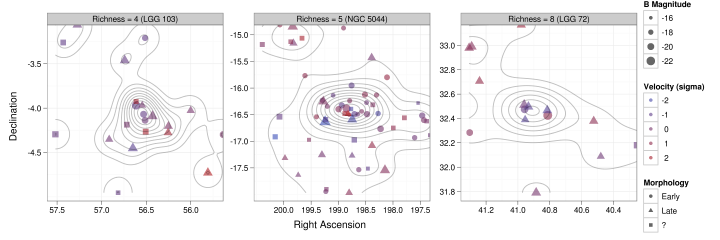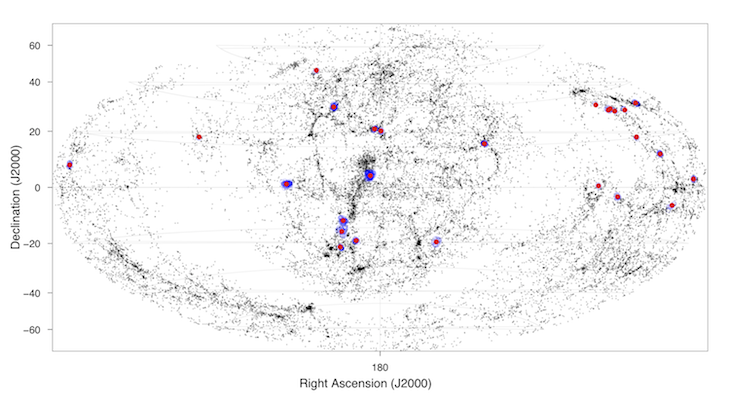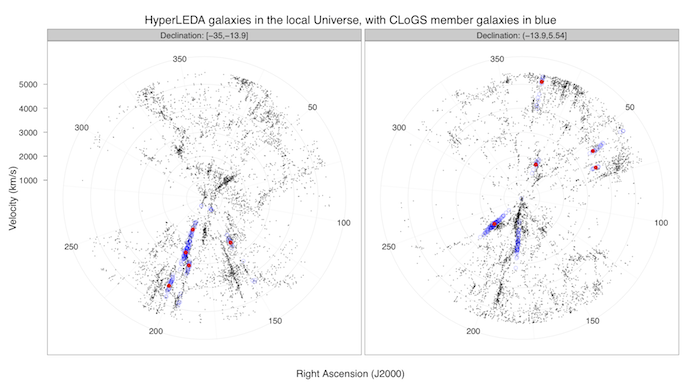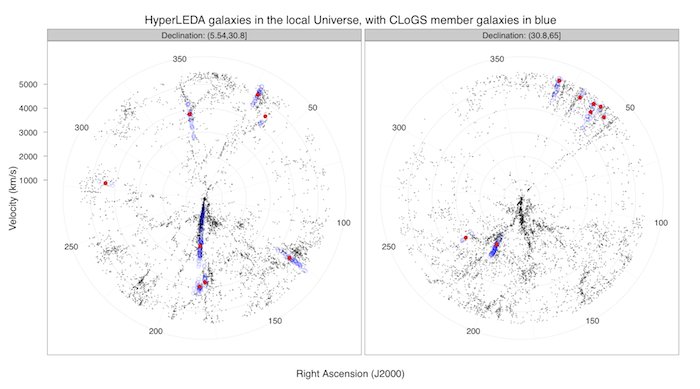Sample Selection
Since group catalogues based on SDSS/2dFGRS cover limited areas of the sky and rarely include large nearby galaxies, we start from the shallow, all-sky LGG catalogue of Garcia (1993) and test the reality of the groups using the best available optical data. The LGG sample is based on an early version of the LEDA galaxy catalogue containing 23490 galaxies, complete to mB=14 and vrec=5500 km/s (equivalent to D<80 Mpc, correcting for Virgocentric flow). Groups were identied by friends-of-friends and hierarchical clustering algorithms, the final sample consisting of systems identified by both method. We select groups within this sample which have:
- 4 or more member galaxies, excluding small associations which may lack a group-scale dark halo,
- 1 or more early-type member galaxy,
- optical luminosity LB of at least 3x1010Lsol for the brightest early-type galaxy, and
- Declination >-30°, to ensure visibility from the GMRT and VLA.
Groups with early-type galaxies are typically more X-ray luminous (Mulchaey et al. 2003) and are more likely to be collapsed systems able to drive galaxy evolution through mergers.
We next refine and expand the group membership using the HyperLEDA catalogue which contains ~105 galaxies with known mB within 10,000 km/s. We select galaxies within 1 Mpc and 2000 km/s of the brightest group-member early-type (BGE) galaxy and iteratively determine the mean group velocity and velocity dispersion using a robust estimator (the gapper algorithm, Beers et al. 1990). Galaxies within 3 sigma of the mean velocity are considered group members. The spatial distribution of galaxies is then examined using isopleth maps (see the Figure below). We exclude cluster subgroups and groups with no clear central galaxy density peak, and cases where the BGE has been mis-identified are re-evaluated. The groups thus selected typically have >20 member galaxies.

We define a richness parameter R as the number of galaxies with log LB >=10.2 (equivalent to the 90% completeness limit of LEDA at our distance limit) within 1 Mpc and 3 sigma of the BGE. R > 10 systems are known clusters and are excluded. We discard six groups with R = 1 which, while probably bound systems (e.g., HCG 42), are too poor to allow reliable determination of physical parameters.
Of the remaining 53 groups, only 24 (45%) had been observed by Chandra or XMM-Newton prior to this project. The observed systems have typical temperatures of 0.5-1.7 keV.
The images below show the locations of the groups among the filamentary structures of the local volume, projected on the sky or in velocity space. Blue circles mark member galaxies, red points are dominant ellipticals, all other galaxies in the local volume are marked in black.



High- and Low-Richness Subsamples
Since the high oversubscription rates of Chandra and XMM-Newton make acquisition of new data for large samples difficult, we divided the CLoGS groups into two statistically complete sub-samples. We now have complete X-ray and low-frequency radio observations of the full 53-group sample. The groups, along with a summary of the data available (or where observations have been approved), are listed below:
| LGG | BGE | D | R | sigma | X-ray | Radio | LGG | BGE | D | R | sigma | X-ray | Radio | ||
|---|---|---|---|---|---|---|---|---|---|---|---|---|---|---|---|
| (Mpc) | (km/s) | (Mpc) | (km/s) | ||||||||||||
| High-Richness Subsample | |||||||||||||||
| 072 | NGC 1060 | 76 | 8 | 496 | X,C | 610,235 | 473 | NGC 7619 | 54 | 8 | 466 | X,C | 610,235 | ||
| 009 | NGC 193 | 74 | 7 | 493 | C | 610,235 | 031 | NGC 677 | 78 | 7 | 249 | X | 610,235 | ||
| 066 | NGC 978 | 69 | 7 | 209 | X | 610,235 | 278 | NGC 4261 | 32 | 7 | 743 | X,C | 610,235 | ||
| 351 | NGC 5153 | 60 | 7 | 251 | C | 610,235 | 363 | NGC 5353 | 35 | 7 | 240 | X,C | 610,235 | ||
| 018 | NGC 410 | 77 | 6 | 393 | X,C | 610,235 | 158 | NGC 2563 | 65 | 6 | 379 | X,C | 610,235 | ||
| 185 | NGC 3078 | 34 | 6 | 1013 | C | 610,235 | 042 | NGC 777 | 73 | 5 | 291 | X,C | 610,235 | ||
| 338 | NGC 5044 | 38 | 5 | 336 | X,C | 610,235 | 393 | NGC 5846 | 26 | 5 | 717 | X,C | 610,235 | ||
| 027 | NGC 584 | 25 | 4 | 160 | C | 610,235 | 058 | NGC 940 | 74 | 4 | 229 | X | 610,235 | ||
| 061 | NGC 924 | 64 | 4 | 126 | X | 610,235 | 080 | NGC 1167 | 72 | 4 | 94 | X | 610,235 | ||
| 103 | NGC 1453 | 63 | 4 | 537 | X | 610,235 | 117 | NGC 1587 | 51 | 4 | 126 | C | 610,235 | ||
| 262 | NGC 4008 | 54 | 4 | 230 | X | 610,235 | 276 | NGC 4169 | 45 | 4 | 93 | X | 610,235 | ||
| 310 | ESO 507-25 | 45 | 4 | 557 | C | 610,235 | 345 | NGC 5084 | 23 | 4 | 680 | C | 610,235 | ||
| 402 | NGC 5982 | 44 | 4 | 230 | X,C | 610,235 | 421 | NGC 6658 | 63 | 4 | 241 | X | 610,235 | ||
| Low-Richness Subsample | |||||||||||||||
| 006 | NGC 128 | 60 | 3 | 669 | X,C | 610,235 | 012 | NGC 252 | 72 | 3 | 675 | X | 610,235 | ||
| 078 | NGC 1106 | 64 | 3 | 776 | X | 610,235 | 097 | NGC 1395 | 21 | 3 | 168 | X,C | 610,235 | ||
| 126 | NGC 1779 | 45 | 3 | 443 | X | 610,235 | 138 | NGC 2292 | 30 | 3 | 325 | X | 610,235 | ||
| 177 | NGC 2911 | 45 | 3 | 288 | X | 610,235 | 205 | NGC 3325 | 80 | 3 | 463 | X | 610,235 | ||
| 232 | NGC 3613 | 32 | 3 | 442 | X,C | 610,235 | 314 | NGC 4697 | 18 | 3 | 1022 | X,C | 610,235 | ||
| 341 | NGC 5061 | 28 | 3 | 423 | X | 610,235 | 370 | NGC 5444 | 60 | 3 | 316 | X | 610,235 | ||
| 398 | NGC 5903 | 36 | 3 | 421 | X,C | 610,235 | 014 | NGC 315 | 73 | 2 | 846 | X,C | 610,235 | ||
| 023 | NGC 524 | 34 | 2 | 216 | X,C | 610,235 | 100 | NGC 1407 | 23 | 2 | 368 | X,C | 610,235 | ||
| 113 | NGC 1550 | 53 | 2 | 576 | X,C | 610,235 | 167 | NGC 2768 | 23 | 2 | 706 | C | 610,235 | ||
| 236 | NGC 3665 | 32 | 2 | 91 | X,C | 610,235 | 255 | NGC 3923 | 20 | 2 | 207 | X,C | 610,235 | ||
| 329 | NGC 4956 | 71 | 2 | 88 | X | 610,235 | 350 | NGC 5127 | 72 | 2 | 794 | X | 610,235 | ||
| 360 | NGC 5322 | 29 | 2 | 254 | X,C | 610,235 | 376 | NGC 5490 | 71 | 2 | 303 | X,C | 610,235 | ||
| 383 | NGC 5629 | 67 | 2 | 267 | X | 610,235 | 457 | NGC 7252 | 66 | 2 | 397 | X,C | 610,235 | ||
| 463 | NGC 7377 | 46 | 2 | 120 | X | 610,235 | |||||||||
C and X indicate Chandra and XMM-Newton data respectively. Values in the Radio column indicate whether GMRT 610 or 235 MHz data are available; in some cases 327 and 150 MHz data are also in the archive. Bold entries indicate data awarded to our proposals for this project.